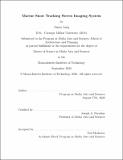| dc.contributor.advisor | Joseph A. Paradiso. | en_US |
| dc.contributor.author | Jang, Junsu | en_US |
| dc.contributor.other | Program in Media Arts and Sciences (Massachusetts Institute of Technology) | en_US |
| dc.date.accessioned | 2021-01-06T20:16:10Z | |
| dc.date.available | 2021-01-06T20:16:10Z | |
| dc.date.copyright | 2020 | en_US |
| dc.date.issued | 2020 | en_US |
| dc.identifier.uri | https://hdl.handle.net/1721.1/129279 | |
| dc.description | Thesis: S.M., Massachusetts Institute of Technology, School of Architecture and Planning, Program in Media Arts and Sciences, September, 2020 | en_US |
| dc.description | Cataloged from student-submitted PDF version of thesis. | en_US |
| dc.description | Includes bibliographical references (pages 123-132). | en_US |
| dc.description.abstract | The transport of particles of organic carbon from the ocean's surface to its bottom plays a key role in the global carbon cycle and carbon sequestration. Quantifying the rate of this Biological Carbon Pump - the size and velocity distribution of falling particles below the mixing layer, for example - is thus of considerable importance. The complexity of this Pump, however, together with systematic biases in available measurement methodologies and vast spatial and temporal undersampling, makes this quantification difficult. In this thesis I set out to design and build a low-cost underwater stereo-imaging system to remotely measure the flux of sinking particles in the mid-ocean. By recording time-lapsed images of marine snow falling through the imaging volume over day-to- week timescales, we can estimate both the particle size distributions and, via 3D particle tracking velocimetry, their velocity distributions too. This allows us to directly estimate the net flux. Making the system low-cost and compact enables largescale observations capable of resolving relevant length and time-scales over which this flux likely varies in the ocean. The hardware design is thus primarily constrained by the target depth, expected particle size distribution, expected sinking rates, deployment duration, and cost. The resulting prototype was then tested in the lab and, computationally, against simulated data in preparation for eventual deployment the Minion platform, a Lagrangian float designed to quantitatively explore the Biological Carbon Pump. An evaluation of the system's efficacy in estimating particle concentration and sinking rate, and ultimately estimate the particle flux, indicates a good match to our target specifications. | en_US |
| dc.description.statementofresponsibility | by Junsu Jang. | en_US |
| dc.format.extent | 132 pages | en_US |
| dc.language.iso | eng | en_US |
| dc.publisher | Massachusetts Institute of Technology | en_US |
| dc.rights | MIT theses may be protected by copyright. Please reuse MIT thesis content according to the MIT Libraries Permissions Policy, which is available through the URL provided. | en_US |
| dc.rights.uri | http://dspace.mit.edu/handle/1721.1/7582 | en_US |
| dc.subject | Program in Media Arts and Sciences | en_US |
| dc.title | Marine snow tracking stereo imaging system | en_US |
| dc.type | Thesis | en_US |
| dc.description.degree | S.M. | en_US |
| dc.contributor.department | Program in Media Arts and Sciences (Massachusetts Institute of Technology) | en_US |
| dc.identifier.oclc | 1227786109 | en_US |
| dc.description.collection | S.M. Massachusetts Institute of Technology, School of Architecture and Planning, Program in Media Arts and Sciences | en_US |
| dspace.imported | 2021-01-06T20:16:09Z | en_US |
| mit.thesis.degree | Master | en_US |
| mit.thesis.department | Media | en_US |
